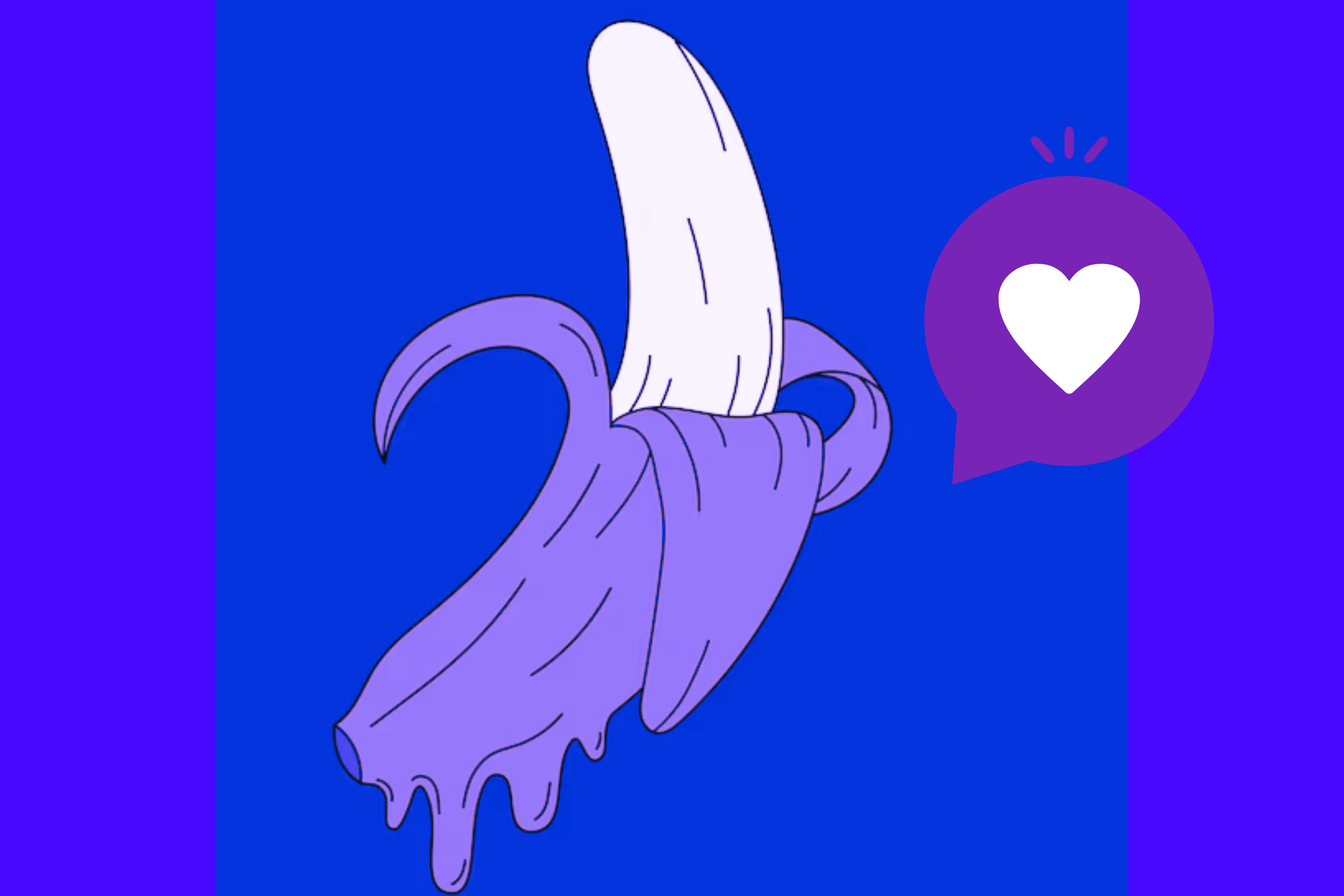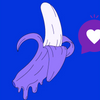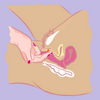The Anatomy Of Penis Owner’s Pleasure

Now that we’ve told you just about everything you need to know about the genital system of vagina owners, we’re going to explore the anatomy of penis owners, because yes, one of the first step to having a better sex life is knowing your anatomy, or the one of your partner(s)! Again, I won't go into a biology lesson, but I will focus on the penis and its sensitive areas, on other parts that play a big role in sexual pleasure and on how to stimulate these erogenous zones for even more fun in the bedroom or wherever you like it!
Before, let's take a quick look at what the genital system of people with a penis is composed of. First, the external genitalia: the penis and the scrotum, then, the internal genitalia: the testicles, the epididymis, the urethra, the vas deferens, the ejaculatory ducts, the seminal vesicles, the prostate and Cowper's glands (bulbo -urethral). (See the picture below)

The Penis
It looks pretty straightforward, but a penis is actually quite complex. The penis is anatomically divided into 3 areas—the body (external portion or shaft), the root (at the level of the perineum) and the glans (the head). The penis is an organ made up of two different types of tissue (2 cavernous bodies and 1 spongy body), as well as nerves and blood vessels. The spongy tissue fills with blood, causing an erection when the nervous system allows it. Indeed, to have an erection, the person must be excited or in 'relaxation mode'. This is why many people wake up with an erection or why some people who are under stress find it difficult to achieve or maintain an erection. There are also 3 muscles surrounding the penis: the ischio-cavernous muscle, the bulbospongiosus muscle and the superficial transverse perineal muscle. These are striated muscles with voluntary or reflex contraction, serving as "tourniquets" at the base of the penis, ensuring rigidity.
To pleasure the penis, you can use your hand to find a rhythm you (or your partner(s) love(s). Some people enjoy rapid strokes, some enjoy slower strokes, and others like a variety when it comes to reaching orgasm. There is no limit to the ways you can use your hand to explore the penis. When performing oral sex on a penis, focus your attention on the head, frenulum and foreskin (if still in tact). Of course, every penis is different and enjoys different sensations, so be sure to check in with the receiver. Once the penis is well lubricated, run your lips and tongue up and down along the shaft. As you move toward the head of the penis, move your tongue in circular motions clockwise and counter-clockwise, and don’t forget that you can still use your hands at the same time!
Glans
The glans is the bulbous part at the tip of the penis that looks like a hat , that you probably know as the head. It is formed by the spongy body and it’s generally the most sensitive part of the penis, due to its 4000 nerve endings. The increase of arterial flow during erection fills the erectile tissue with blood causing the glans to grow in size and sensitivity. While the penis is rigid when erect, the glans itself remains slightly softer in order to absorb impact during vigorous intercourse. At the summit of the glans is the opening of the urethra through which urine, semen and pre-ejaculatory fluid exit the penis.
If you want to increase pleasure and enhance sensations, then don't neglect this part. Apply some lubricant to your hands (to avoid friction and laces) and firmly grip the penis with one hand, while with the other, begin to rub the glans in a gentle, circular motion. Putting a little pressure on the glans with your hands is very enjoyable for most penis owners, but it must always be done very gently.
Frenulum
The frenulum of the penis is a band of tissue found where the foreskin (prepuce) intersects with the head (glans) of the underside of your penis. Even if you have a circumcised penis, a small piece of the frenulum may remain. It’s often shaped like the letter “V.” It's typically supple enough to allow manual movement of the foreskin over the glans and help retract the foreskin during erection. In a flaccid state it tightens to narrow the foreskin opening. As part of the glans penis, the frenulum is innervated by divisions of the pudendal nerve; the dorsal nerve of the penis and a branch of the perineal nerve. The frenulum is very sensitive and can lead to a big orgasm.
Stimulating this area is very different from a firm hand, mouth or vagina encompassing the penis. The person will need to relax their body and allow the gradual build up of pleasure to eventually overtake them. To stimulate the frenulum you could use your mouth, the tip of your nose, your fingers, your thumb or a vibrator. There should be no opposing force on the other side of the shaft. Probably one of the best ideas is to just think of what would feel good on the clitoris and try it on the frenulum. Again, don’t forget to use lube, as this area is very sensitive to laces.
Foreskin
If the person is not circumcised, the foreskin is designed to form a double layer of skin that is long enough to cover the shape of the penis and enclose the glans. When the penis is at rest, most of the skin is there to cover the glans. This double layer of skin protects the thousands of nerve endings and the very sensitive skin it covers. As the penis gets harder during erection, the foreskin performs one of its major functions: it rolls over itself, giving the penis the ability to lengthen, while allowing the skin to remain relaxed. It is mobile, fairly stretchable and sustains the glans in a moist environment.
When the glans is uncovered, the layer of skin inside the foreskin as well as the glans is exposed. Both surfaces are very sensitive to touch. Therefore, when the foreskin is stretched or massaged, the thousands of nerve endings send messages to the brain, which are actually stimulating sexual signals. To do so, you can hold the foreskin at the bulb of the penis (at the base) and gently pull it back and forth over the bulb. This action will become more frantic and vigorous as you approach climax to the point where you stretch the entire foreskin back and orgasm. Again, lube it up!
Scrotum and testicles
The scrotum is the muscular sack surrounded by skin that contains the testicles. It is composed of several layers of tissue and is responsible for protecting the testicles. It actually helps thermoregulate them by keeping their temperature 2-4°C lower than the average body temperature, which is essential for sperm production.
The testicles, located inside the scrotum, are attached by the spermatic cord and the scrotal ligaments. They have two functions: the production of spermatozoa (spermatogenesis) and the secretion of testosterone.
As you probably know, for the bad and the good, the ball sack is packed with nerve endings that can create incredibly intense sensations. However, with the right touch, that sensation can be one of pleasure. Also, stimulating them may promote ejaculatory production. To try different sensations, you can squeeze them carefully during masturbation by the other when getting a hand job or a BJ. You can also stroke them at a downward angle, roll them in your hands, pull them gently or whatever feels good. Licking and light sucking are also usually fair game. Ball stretchers are also an option for those who are looking to explore other sensations!
Perineum
The official medical definition of the perineum refers to it as a diamond-shaped area, split into two triangles. They are called the urogenital triangle and the anal triangle.
It lies just below the pelvic floor muscles, which support the bladder and bowel. It protects the pelvic floor muscles and the blood vessels that supply the genitals and urinary tract. The perineum also protects the nerves used to urinate or have an erection. It is the area between the scrotum and the anus and it is a very sensitive area, from which the prostate can be stimulated. Indeed, it has massive orgasm potential!
To massage this area, start at the anus. You want to locate what feels like a cable of fibers that run vertically under the skin, from around the anus to the base of the penis. It will feel like a wide rope. Once you have located it, place your index and middle fingers on either side of the cable. Gently press and move your fingers back and forth across the ‘’rope’’, slowly making your way up towards the base of the penis. This massage should not be painful at all; if it is, you are pushing too hard. Spend several seconds massaging one area before moving on to the next.Many also enjoy the feeling of having their perineum licked and teased with a tongue, fingers, or vibrators.
Prostate
The prostate, or what is also called the P-spot, is a small sexual gland that produces a prostatic fluid that nourishes and protects your sperm. This milky fluid makes up about 20% of the volume of the ejaculation. The prostate also allows ejaculation by contracting itself. It promotes fertility through its enzymes that facilitate the penetration of sperm through the cervix. It is located just in front of the rectum, under the bladder. It is about the size of a walnut, but increases in size after the age of 40. The prostate itself is also very sensitive when simulated since it is surrounded by lots of nerve endings. Many people even say that massaging the prostate can lead to a more intense pleasure than the orgasm felt at the time of ejaculation.
To find the prostate, you can gently insert a well-lubricated finger into the rectum. As you move up towards the anus, you will feel that the prostate is fleshier and softer than the surrounding area. If you feel an increase in sensation, you're in the right spot. It's normal to feel the urge to pee at the same time. Now, if you are at this stage, the prostate can be stimulated with your fingers, but also with the use of sex toys such as butt plugs, anal dildos or prostate massagers, by gently massaging it. Don't forget to always use anal lubricant.
In conclusion, the genital system of penis owner is a complex and intricate network of pleasure zones that can provide immense pleasure when stimulated correctly. Understanding the anatomy and physiology of the genital system can help individuals and their partners achieve more satisfying sexual experiences. Once again, it’s essential to prioritize communication, experimentation and consent to unlock a world of pleasure and connection!
Sources:
- Aaron L, Franco OE, Hayward SW. Review of Prostate Anatomy and Embryology and the Etiology of Benign Prostatic Hyperplasia. Urol. Clin. North Am. 2016 Aug;43(3):279‐88.
- Cunha, G.R. et al.(2018). Development of the human prostate, Differentiation, Volume 103, September–October Pages 24‐45, https://doi.org/10.1016/j.diff.2018.08.005.
- Garcia RA, Sajjad H. Anatomy, Abdomen and Pelvis, Scrotum. [Updated 2020 Jul 31]. In: StatPearls [Internet]. Treasure Island (FL): StatPearls Publishing; 2020 Jan‐. Available from: https://www.ncbi.nlm.nih.gov/books/NBK549893/.
- McKay AC, Odeluga N, Jiang J, et al. Anatomy, Abdomen and Pelvis, Seminal Vesicle. [Updated 2020 Jul 27]. In: StatPearls [Internet]. Treasure Island (FL): StatPearls Publishing; 2020 Jan‐. Available from: https://www.ncbi.nlm.nih.gov/books/NBK499854/.
- Tiwana MS, Leslie SW. Anatomy, Abdomen and Pelvis, Testicle. [Updated 2020 Jul 27]. In: StatPearls [Internet]. Treasure Island (FL): StatPearls Publishing; 2020 Jan‐. Available from: https://www.ncbi.nlm.nih.gov/books/NBK470201/.
- Singh O, Bolla SR. Anatomy, Abdomen and Pelvis, Prostate. [Updated 2019 Apr 9]. In: StatPearls [Internet]. Treasure
- Bourbonnais, Gilles. (2015). Biologie générale, Notes de cours BIO ‐0150, Université Laval.
- Guérin, J.‐F. (2016) Chapitre 8 – La spermatogenèse. Infertilité, Elsevier Masson, pages 59‐64, ISBN 9782294745904, https://doi.org/10.1016/B978‐2‐294‐74590‐4.00008‐3.
- Giuliano F, Clement P. Neuroanatomy and physiology of ejaculation. Annu Rev Sex Res. 2005;16:190‐216.
- Hsieh C‐H, et al., Penile venous surgery for treating erectile dysfunction: Past, present, and future perspectiveswith regard to new insights in venous anatomy, Urological Science (2015), http://dx.doi.org/10.1016/j.urols.2015.11.002
- OpenStax, Anatomy and Physiology. OpenStax CNX. May 29, 2019 http://cnx.org/contents/14fb4ad7‐39a1‐4eee‐ab6e‐ 3ef2482e3e22@15.5
- Schlegel P.N., Katzovitz M.A. (2020) Male Reproductive Physiology. In: Chapple C., Steers W., Evans C. (eds) Urologic Principles and Practice. Springer Specialist Surgery Series. Springer, Cham. https://doi.org/10.1007/978‐3‐030‐28599‐9_3
- Celigoj F.A., Coward R.M., Timberlake M.D., Smith R.P. (2016) Anatomy and Physiology of Erection, Ejaculation, and Orgasm. In: Lipshultz L., Pastuszak A., Goldstein A., Giraldi A.,
- Clement, P., & Giuliano, F. (2015). Anatomy and physiology of genital organs - men. Handbook of clinical neurology, 130, 19–37. https://doi.org/10.1016/B978-0-444-63247- 0.00003-1
- Kahle W, Frotscher M, ed. Color Atlas of Human Anatomy, Vol. 3: Nervous System and Sensory Organs. 6th Edition. Thieme; 2010. doi:10.1055/b-005-148911.
- Lejeune, Hervé. (2012) Anatomie et physiologie de l’appareil sexuel masculin. Repéré au https://sexoblogue.fr/cours-de-sexologie/la-sexualite-normale/biologie-de-la-sexualite/lappareil-sexuel-masculin-anatomie-physiologie.
- Sam P, LaGrange CA. Anatomy, Abdomen and Pelvis, Penis. [Updated 2020 May 20]. In: StatPearls [Internet]. Treasure Island (FL): StatPearls Publishing; 2020 Jan-. Available from: https://www.ncbi.nlm.nih.gov/books/NBK482236/
- Sieman,Michel. (n.d.) Archives Larousse. Repéré au https://www.larousse.fr/encyclopedie/medical/appareil_g%C3%A9nital_masculin/13292#10989590.
- Yiee, J.H. and Baskin, L.S.(2010). Penile embryology and anatomy.TheScientificWorldJOURNAL: TSW Urology10, 1174–1179. DOI 10.1100/tsw.2010.112.
- Wein, A. J., Kavoussi, L. R., Novick, A. C., Partin, A. W., & Peters, C. A. (2011). Campbell-walsh urology. ProQuest Ebook Central https://ebookcentral.proquest.com





